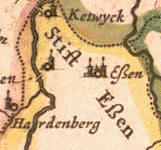ß
In German orthography, the letter, ß, called Eszett (IPA: [ɛsˈtsɛt]) or scharfes S (IPA: [ˈʃaɐ̯fəs ˈʔɛs], [ˈʃaːfəs ˈʔɛs], lit. "sharp S"), represents the /s/ phoneme in Standard German when following long vowels and diphthongs. The name Eszett combines the names of the letters of ⟨s⟩ (Es) and ⟨z⟩ (Zett) in German. The character's Unicode names in English are sharp s[1] and eszett.[1] ß is only used in German, and it can be replaced with ⟨ss⟩ if the character is unavailable or capitalized. In the 20th century, it was completely replaced by ⟨ss⟩ in Swiss Standard German (used in Switzerland and Liechtenstein),[2] while it remains part of the orthography of Standard German elsewhere.
| ẞ | ß |
- For the notation
⟨ ⟩,/ /and[ ]used in this article, see grapheme, phoneme and International Phonetic Alphabet respectively.
The letter originates as the ⟨sz⟩ digraph as used in late medieval and early modern German orthography, represented as a ligature of long s and a 'tailed z' () in blackletter typefaces (yielding ſʒ),[lower-alpha 1]. This developed from an earlier usage of ⟨z⟩ in Old and Middle High German to represent a separate sibilant sound from ⟨s⟩; when the difference between the two sounds was lost in the thirteenth century, the two symbols came to be combined as ⟨sz⟩ in some situations.
Traditionally, ß did not have a capital form, although some type designers introduced de facto capitalized variants of ß. In 2017, the Council for German Orthography ultimately adopted capital ß, ẞ, into German orthography, ending a long orthographic debate.[3]
⟨ß⟩ was encoded by ECMA-94 (1985) at position 223 (hexadecimal DF), inherited by Latin-1 and Unicode (U+00DF ß LATIN SMALL LETTER SHARP S).[4]
The HTML entity ß was introduced with HTML 2.0 (1995). The capital variant (U+1E9E ẞ LATIN CAPITAL LETTER SHARP S) was encoded by ISO 10646 in 2008.
Usage
Current usage
In standard German, three letters or combinations of letters commonly represent [s] (the voiceless alveolar fricative) depending on its position in a word: ⟨s⟩, ⟨ss⟩, and ⟨ß⟩. According to the current German orthography, ⟨ß⟩ represents the sound [s]:
- when it is written after a diphthong or long vowel and is not followed by another consonant in the word stem: Straße, Maß, groß, heißen [Exceptions: aus and words with final devoicing (e.g. Haus)];[5]
- when a word stem ending with ß takes an inflectional ending beginning with a consonant: heißt, größte.[6]
In verbs with roots where the vowel changes length, this means that some forms may be written with ⟨ß⟩, others with ⟨ss⟩: wissen, er weiß, er wusste.[5]
The use of ⟨ß⟩ distinguishes minimal pairs such as reißen (IPA: [ʁaɪsn̩], to rip) and reisen (IPA: [ʁaɪzn̩], to travel) on the one hand ([s] vs. [z]), and Buße (IPA: [bu:sə], penance) and Busse (IPA: [bʊsə], buses) on the other (long vowel before ⟨ß⟩, short vowel before ⟨ss⟩).[7]
In pre-1996 orthography
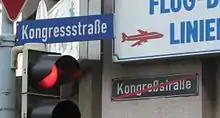
According to the orthography in use in German prior to the German orthography reform of 1996, ⟨ß⟩ was written to represent [s] in the following instances:
- word internally following a long vowel or diphthong: Straße, reißen;
- instead of ⟨ss⟩ at the end of a word (including an element in a compound) or syllable: muß, faßt.
In the old orthography, word stems spelled ⟨ss⟩ internally could thus be written ⟨ß⟩ in certain instances, without this reflecting a change in vowel length: küßt (from küssen), faßt (from fassen), verläßlich and Verlaß (from verlassen), kraß (comparative: krasser).[8]
The spelling reform affected some German-language forms of foreign place names, such as Rußland ("Russia"), reformed Russland, and Preßburg ("Bratislava"), reformed Pressburg. The orthography of personal names (first names and family names) and of names for locations within Germany proper, Austria and Switzerland were not affected by the reform of 1996, however; these names often use irregular spellings that are otherwise impermissible under German spelling rules, not only in the matter of the 'ß' but also in many other respects.
Substitution and all caps

If no 'ß' is available, 'ss' or 'sz' is used instead ('sz' especially in Hungarian-influenced eastern Austria). Until 2017, there was no official capital form of ß; however a capital form was nevertheless frequently used in advertising and government bureaucratic documents.[9] In June of that year, the Council for German Orthography officially adopted a rule that ẞ would be an option for capitalizing ß besides the previous capitalization as SS (i.e. variants STRASSE vs. STRAẞE would be accepted as equally valid).[10] [11] Prior to this time, it was recommended to render ß as SS in allcaps except when there was ambiguity, in which case it should be rendered as SZ. The common example for such a case was IN MASZEN (in Maßen "in moderate amounts") vs. IN MASSEN (in Massen "in massive amounts"), where the difference between the spelling in ß vs. ss could actually reverse the conveyed meaning.
Switzerland and Liechtenstein
In Swiss Standard German, 'ss' usually replaces every 'ß'. This is officially sanctioned by the reformed German orthography rules, which state in §25 E2: "In der Schweiz kann man immer „ss“ schreiben" ("In Switzerland, one may always write 'ss'"). Liechtenstein follows the same practice.
Uncommon uses
Occasionally, ß has been used in unusual ways:
- As a surrogate for Greek lowercase beta (β), which looks fairly similar. This was used in older operating systems, whose character encodings (notably Latin-1 and Windows-1252) did not support easy use of Greek letters. Also, the original IBM DOS code page, CP437 (aka OEM-US) (which contains some Greek letters for technical and scientific usage) conflates the two characters, assigning them the same code point (0xE1) and a glyph that minimizes their differences.
- 'ß' was used to represent /ʃ/ in a German-influenced spelling system for the Lithuanian language which was used in Lithuania Minor in East Prussia, which can be seen, for example, in some surnames.
- 'ß' has also occasionally been used for transliterating Sumerian /ʃ/, the standard transliteration of which is ⟨š⟩.
History
Origin and development
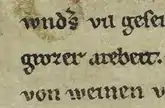
As a result of the High German consonant shift, Old High German developed a sound generally spelled ⟨zz⟩ or ⟨z⟩ that probably was pronounced [s] and was contrasted with a sound, probably pronounced [ɕ] (voiceless alveolo-palatal fricative) or [ʒ] (voiced postalveolar fricative) and spelled ⟨s⟩.[12] Because ⟨z⟩ could also represent the affricate [ts], some attempts were made to differentiate the sounds by spelling [s] as ⟨zss⟩ or ⟨zs⟩: wazssar (German: Wasser), fuozssi (German: Füße), heizsit (German: heißt).[13] In Middle High German, ⟨zz⟩ simplified to ⟨z⟩ at the end of a word or after a long vowel, but was retained word internally after a short vowel: wazzer (German: Wasser) vs. lâzen (German: lassen) and fuoz (German: Fuß).[14]

In the thirteenth century, the phonetic difference between ⟨z⟩ and ⟨s⟩ was lost at the beginning and end of words in all dialects except for Gottscheerish.[12] Word internally, Old and Middle High German ⟨s⟩ came to be pronounced [z] (the voiced alveolar sibilant), while Old and Middle High German ⟨z⟩ continued to be pronounced [s]. This produces the contrast between modern standard German reisen and reißen. The former is pronounced IPA: [ʁaɪzn̩] and comes from Middle High German: reisen, while the latter is pronounced IPA: [ʁaɪsn̩] and comes from Middle High German: reizen.[15]
In the late medieval and early modern periods, [s] was frequently spelled ⟨sz⟩ or ⟨ss⟩. The earliest appearance of ligature resembling the modern ⟨ß⟩ is in a fragment of a manuscript of the poem Wolfdietrich from around 1300.[16] In the Gothic book hands and bastarda scripts of the late medieval period, ⟨sz⟩ is written with long s and the Blackletter "tailed z", as ſʒ. A recognizable ligature representing the ⟨sz⟩ digraph develops in handwriting in the early 14th century.[17]

By the late 1400s, the choice of spelling between ⟨sz⟩ and ⟨ss⟩ was usually based on the sound's position in the word rather than etymology: ⟨sz⟩ (⟨ſz⟩) tended to be used in word final position: uſz (Middle High German: ûz, German: aus), -nüſz (Middle High German: -nüss(e), German: -nis); ⟨ss⟩ (⟨ſſ⟩) tended to be used when the sound occurred between vowels: groſſes (Middle High German: grôzes, German: großes).[18] While Martin Luther's early 16th-century printings also contain spellings such as heyße (German: heiße), early modern printers mostly changed these to ⟨ſſ⟩: heiſſe. Around the same time, printers began to systematically distinguish between das (the, that [pronoun]) and daß (that [conjunction]).[19]
In modern German, the Old and Middle High German ⟨z⟩ is now represented by either ⟨ss⟩, ⟨ß⟩, or, if there are no related forms in which [s] occurs intervocalically, with ⟨s⟩: messen (Middle High German: mezzen), Straße (Middle High German: strâze), and was (Middle High German: waz).[14]
Standardization of use
The pre-1996 German use of ß was codified by the eighteenth-century grammarians Johann Christoph Gottsched (1748) and Johann Christoph Adelung (1793) and made official for all German-speaking countries by the German Orthographic Conference of 1901. In this orthography, the use of ß was modeled after the use of long and "round"-s in Fraktur. ß appeared both word internally after long vowels and also in those positions where Fraktur required the second s to be a "round" or "final" s, namely the ends of syllables or the ends of words.[20] In his Deutsches Wörterbuch (1854) Jacob Grimm called for ⟨ß⟩ or ⟨sz⟩ to be written for all instances of Middle and Old High German etymological ⟨z⟩ (e.g. eß instead of es from Middle High German: ez); however, his etymological proposal could not overcome established usage.[21]
In Austria-Hungary prior to the German Orthographic Conference of 1902, an alternative rule formulated by Johann Christian August Heyse in 1829 had been officially taught in the schools since 1879, although this spelling was not widely used. Heyse's rule matches current usage after the German orthography reform of 1996 in that ß was only used after long vowels.[22]
Use in Roman Type
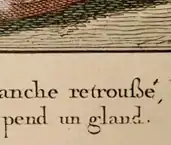
Although there are early examples in Roman type of a 'ſs'-ligature that looks like the letter ß, it was not commonly used for 'sz'.[23][24] In the late 18th and early 19th century, when more and more German texts were printed in Roman type (Antiqua), typesetters looked for an exact Roman counterpart for the blackletter ſʒ ligature, which did not exist in Roman fonts. Printers experimented with various techniques, mostly replacing blackletter ß in Roman type with either 'sz', 'ss', 'ſs', or some combination of these. The Brothers Grimm favored writing sz, whereas the First Orthographic Conference in Berlin recommended that ß be represented as ſs - however, both suggestions were ultimately rejected.[25] In 1879, a proposal for various letter forms was published in the Journal für Buchdruckerkunst. A committee of the Typographic Society of Leipzig chose the "Sulzbacher form". In 1903 it was proclaimed as the new standard for the Eszett in Roman type.[26]
Since then, German printing set in Roman type has used the letter ß. The Sulzbacher form, however, did not find unanimous acceptance. It became the default form, but many type designers preferred (and still prefer) other forms. Some resemble a blackletter 'sz'-ligature, others more a Roman 'ſs'-ligature.[23]
Abolition and attempted abolitions
The Swiss and Liechtensteiners ceased to use the ß in the twentieth century: this has been explained variously by the early adoption of Roman type in Switzerland, the use of typewriters in Switzerland that did not include ß in favor of French and Italian characters, and peculiarities of Swiss German that cause words spelled with ⟨ß⟩ or ⟨ss⟩ to be pronounced with gemination.[27] The Education Council of Zurich had decided to stop teaching the letter in 1935, whereas the Neue Zürcher Zeitung continued to write ⟨ß⟩ until 1971.[28] Swiss newspapers continued to print in Fraktur until the end of the 1940s, and the abandonment of ß by most newspapers corresponded to them switching to Roman typesetting.[29]
When the Nazi German government abolished the use of blackletter typesetting in 1941, it was originally planned to also abolish the use of ß. However, Hitler intervened to retain ß, while deciding against the creation of a capital form.[30] In 1954, a group of reformers in West Germany similarly proposed, among other changes to German spelling, the abolition of the ß; their proposals were publicly opposed by German-language writers Thomas Mann, Hermann Hesse, and Friedrich Dürrenmatt and were never implemented.[31] Although the German Orthography Reform of 1996 reduced the use of ß in standard German, Adrienne Walder writes that an abolition outside of Switzerland appears unlikely.[32]
Development of a capital form
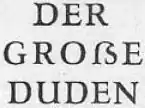

Because ß is treated as a ligature, rather than as a full letter of the German alphabet, it had no capital form in early modern typesetting. There have however been proposals to introduce capital forms of ß for use in allcaps writing (where ß would usually be represented as either 'SS' or 'SZ'). This was first proposed in 1879, but did not enter official or widespread usage.[33] Historical typefaces offering a capitalized eszett mostly date to the time between 1905 and 1930. The first known typefaces to include capital eszett were produced by the Schelter & Giesecke foundry in Leipzig, in 1905/06. Schelter & Giesecke at the time widely advocated the use of this type, but its use remained very limited.
The preface to the 1925 edition of the Duden dictionary expressed the desirability of a separate glyph for capital ß:
Die Verwendung zweier Buchstaben für einen Laut ist nur ein Notbehelf, der aufhören muss, sobald ein geeigneter Druckbuchstabe für das große ß geschaffen ist.[34]
The use of two letters for a single phoneme is makeshift, to be abandoned as soon as a suitable type for the capital ß has been developed.
The Duden was edited separately in East and West Germany during the 1950s to 1980s. The East German Duden of 1957 (15th ed.) introduced a capital ß in its typesetting without revising the rule for capitalisation. The 16th edition of 1969 still announced that an uppercase ß was in development and would be introduced in the future. The 1984 edition again removed this announcement and simply stated that there is no capital version of ß.[35]
In the 2000s, there were renewed efforts on the part of certain typographers to introduce capital ẞ.[36] A proposal to include a corresponding character in the Unicode set submitted in 2004 was rejected.[37] A second proposal submitted in 2007 was successful, and the character was included in Unicode version 5.1.0 in April 2008 (U+1E9E ẞ LATIN CAPITAL LETTER SHARP S).[38] The international standard associated with Unicode (UCS), ISO/IEC 10646, was updated to reflect the addition on 24 June 2008. Capital ß was finally adopted as an option in standard German orthography in 2017.[11]
Representation
Graphical variants
The recommendation of the Sulzbacher form (1903) was not followed universally in 20th-century printing. There were four distinct variants of ß in use in Antiqua fonts:

- ſs without ligature, but as a single type, with reduced spacing between the two letters
- the ligature of ſ and s inherited from the 16th-century Antiqua typefaces
- a ligature of ſ and tailed z, adapting the blackletter ligature to Antiqua
- the Sulzbacher form.
The first variant (no ligature) has become practically obsolete. Most modern typefaces follow either 2 or 4, with 3 retained in occasional usage, notably in street signs in Bonn and Berlin.

Use of typographic variants in street signs:


 Blackletter form of the ſz ligature (Erfurt street signs)
Blackletter form of the ſz ligature (Erfurt street signs) Sulzbacher form (Nürnberg street signs)
Sulzbacher form (Nürnberg street signs) Two distinct blackletter typefaces in Mainz. The red sign spells Straße with ſs; the blue sign uses the standard blackletter ſz ligature.
Two distinct blackletter typefaces in Mainz. The red sign spells Straße with ſs; the blue sign uses the standard blackletter ſz ligature.%252C_StVO_1992.svg.png.webp) Sulzbacher form in the German Einbahnstraße ("one-way street") sign
Sulzbacher form in the German Einbahnstraße ("one-way street") sign
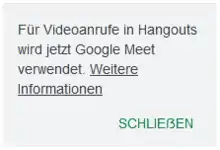
The inclusion of a capital ẞ in ISO 10646 in 2008 revived the century-old debate among font designers as to how such a character should be represented. The main difference in the shapes of ẞ in contemporary fonts is the depiction with a diagonal straight line vs. a curved line in its upper right part, reminiscent of the ligature of tailed z or of round s, respectively. The code chart published by the Unicode Consortium favours the former possibility,[39] which has been adopted by Unicode capable fonts including Arial, Calibri, Cambria, Courier New, Dejavu Serif, Liberation Sans, Liberation Mono, Linux Libertine and Times New Roman; the second possibility is more rare, adopted by Dejavu Sans. Some fonts adopt a third possibility in representing ẞ following the Sulzbacher form of ß, reminiscent of the Greek beta (β); such a shape has been adopted by FreeSans and FreeSerif, Liberation Serif and Verdana.[40]
Keyboards and encoding
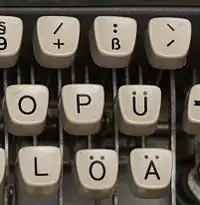
In Germany and Austria, the letter ß is present on computer and typewriter keyboards, normally to the right-hand end on the number row. The German typewriter keyboard layout was defined in DIN 2112, first issued in 1928.[41]
In other countries, the letter is not marked on the keyboard, but a combination of other keys can produce it. Often, the letter is input using a modifier and the 's' key. The details of the keyboard layout depend on the input language and operating system: on some keyboards with US-International (or local 'extended') setting, the symbol is created using AltGrs (or CtrlAlts) in Microsoft Windows, Linux and Chrome OS; in MacOS, one uses ⌥ Options on the US, US-Extended, and UK keyboards. In Windows, one can also use alt code 0223.
Some modern virtual keyboards show ß when the user presses and holds the s key.
The HTML entity for ß is ß. Its code point in the ISO 8859 character encoding versions 1, 2, 3, 4, 9, 10, 13, 14, 15, 16 and identically in Unicode is 223, or DF in hexadecimal. In TeX and LaTeX, \ss produces ß. A German language support package for LaTeX exists in which ß is produced by "s (similar to umlauts, which are produced by "a, "o, and "u with this package).[42]
In modern browsers, "ß" will be converted to "SS" when the element containing it is set to uppercase using text-transform: uppercase in Cascading Style Sheets. The JavaScript in Google Chrome and Mozilla Firefox will convert "ß" to "SS" when converted to uppercase (e.g. "ß".toUpperCase()).
| Preview | ẞ | ß | ||
|---|---|---|---|---|
| Unicode name | LATIN CAPITAL LETTER SHARP S | LATIN SMALL LETTER SHARP S | ||
| Encodings | decimal | hex | decimal | hex |
| Unicode | 7838 | U+1E9E | 223 | U+00DF |
| UTF-8 | 225 186 158 | E1 BA 9E | 195 159 | C3 9F |
| Numeric character reference | ẞ | ẞ | ß | ß |
| Named character reference | ß | |||
| ISO 8859[lower-alpha 2] and Windows-125x[lower-alpha 3] | 223 | DF | ||
| Mac OS script encodings[lower-alpha 4] | 167 | A7 | ||
| DOS code page 437,[67] 850[68] | 225 | E1 | ||
| EUC-KR[69] / UHC[70] | 169 172 | A9 AC | ||
| GB 18030[71] | 129 53 254 50 | 81 35 FE 32 | 129 48 137 56 | 81 30 89 38 |
| EBCDIC 037,[72] 500,[73] 1026[74] | 89 | 59 | ||
| ISO/IEC 6937 | 251 | FB | ||
| Shift JIS-2004[75] | 133 116 | 85 74 | ||
| EUC-JIS-2004[76] | 169 213 | A9 D5 | ||
| KPS 9566-2003[77] | 174 223 | AE DF | ||
| LaTeX[78] | [lower-alpha 5] | \ss | ||
See also
- β, Greek letter β (Beta)
- 阝, Kangxi radical 163 & 170
- Long s (ſ)
- Sz (digraph)
- de:Heysesche s-Schreibung (in German)
- de:Adelungsche s-Schreibung (in German)
Notes
- In this article, the IPA symbol ezh (ʒ) is the most similar to the Blackletter z () and is used in this article for convenience despite its technical inaccuracy.
- Parts 1,[43] 2,[44] 3,[45] 4,[46] 9,[47] 10,[48] 13,[49] 14,[50] 15,[51] 16[52] (i.e. excluding 5, 6, 7, 8, 11)
- Code pages 1250,[53] 1252,[54] 1254,[55] 1257,[56] 1258[57] (i.e. excluding 1251, 1253, 1255, 1256)
- Mac OS Roman,[58] Icelandic,[59] Croatian,[60] Central European,[61] Celtic,[62] Gaelic,[63] Romanian,[64] Greek,[65] Turkish[66]
- The
\SSmacro exists as the uppercase counterpart of\ss, but displays as a doubled capital S.[78]
References
- Unicode Consortium (2018), "C1 Controls and Latin-1 Supplement, Range 0080–00FF" (PDF), The Unicode Standard, Version 11.0, retrieved 2018-08-09.
- Leitfaden zur deutschen Rechtschreibung ("Guide to German Orthography"), 3rd edition (2007) (in German) from the Swiss Federal Chancellery, retrieved 22-Apr-2012
- Ha, Thu-Huong. "Germany has ended a century-long debate over a missing letter in its alphabet". Retrieved 9 August 2017.
According to the council’s 2017 spelling manual: When writing the uppercase [of ß], write SS. It’s also possible to use the uppercase ẞ. Example: Straße — STRASSE — STRAẞE.
- C1 Controls and Latin-1 Supplement glossed 'uppercase is "SS"; nonstandard uppercase is 1E9E ẞ; typographically the glyph for this character can be based on a ligature of 017F long s, ſ, with either 0073 s or with the historic blackletter glyph for 007A z (the latter is similar in appearance to U+0292 ʒ EZH). Both forms exist interchangeably today.'
- "Deutsche Rechschreibung: 2.3 Besonderheiten bei [s] § 25". Retrieved 28 January 2021.
- Duden: Die Grammatik (9 ed.). 2016. p. 84.
- Augst, Gerhard; Stock, Eberhard (1997). "Laut-Buchstaben-Zuordnung". In Augst, Gerhard; et al. (eds.). Zur Neuregelung der deutschen Rechtschreibung: Begründung und Kritik. Max Niemeyer. p. 123. ISBN 3-484-31179-7.
- Augst, Gerhard; Stock, Eberhard (1997). "Laut-Buchstaben-Zuordnung". In Augst, Gerhard; et al. (eds.). Zur Neuregelung der deutschen Rechtschreibung: Begründung und Kritik. Max Niemeyer. pp. 121–123. ISBN 3-484-31179-7., Munske, Horst Haider (2005). Lob der Rechtschreibung: Warum wir schreiben, wie wir schreiben. C. H. Beck. p. 66. ISBN 3-406-52861-9.
- Walder, Adrienne (2020). "Das versale Eszett: Ein neuer Buchstabe im deutschen Alphabet". Zeitschrift für Germanitische Linguistik. 48 (2): 211. doi:10.1515/zgl-2020-2001. S2CID 225226660.
- 3. Bericht des Rats für deutsche Rechtschreibung 2011–2016 (2016), p. 7.
- "Deutsche Rechtschreibung Regeln und Wörterverzeichnis: Aktualisierte Fassung des amtlichen Regelwerks entsprechend den Empfehlungen des Rats für deutsche Rechtschreibung 2016" (PDF). §25, E3. Archived from the original (PDF) on 2017-07-06. Retrieved 29 June 2017.
E3: Bei Schreibung mit Großbuchstaben schreibt man SS. Daneben ist auch die Verwendung des Großbuchstabens ẞ möglich. Beispiel: Straße – STRASSE – STRAẞE. [When writing in all caps, one writes SS. It is also permitted to write ẞ. Example: Straße – STRASSE – STRAẞE.]
- Salmons, Joseph (2018). A History of German: What the past reveals about today's language (2 ed.). Oxford University Press. p. 203. ISBN 978-0-19-872302-8.
- Braune, Wilhelm (2004). Althochdeutsche Grammatik I. Max Niemeyer. p. 152. ISBN 3-484-10861-4.
- Paul, Hermann (1998). Mittelhochdeutsche Grammatik (24 ed.). Max Niemeyer. p. 163. ISBN 3-484-10233-0.
- Penzl, Herbert (1968). "Die mittelhochdeutschen Sibilanten und ihre Weiterentwicklung". Word. 24 (1–3): 344, 348. doi:10.1080/00437956.1968.11435536.
- Walder, Adrienne (2020). "Das versale Eszett: Ein neuer Buchstabe im deutschen Alphabet". Zeitschrift für Germanitische Linguistik. 48 (2): 214. doi:10.1515/zgl-2020-2001. S2CID 225226660., Penzl, Herbert (1968). "Die mittelhochdeutschen Sibilanten und ihre Weiterentwicklung". Word. 24 (1–3): 344, 348. doi:10.1080/00437956.1968.11435536.
- Brekle, Herbert E. (2001). "Zur handschriftlichen und typographischen Geschichte der Buchstabenligatur ß aus gotisch-deutschen und humanistisch-italienischen Kontexten". Gutenberg-Jahrbuch. Mainz. 76: 67–76. ISSN 0072-9094.
- Young, Christopher; Gloning, Thomas (2004). A History of the German Language Through Texts. Routledge. p. 171. ISBN 978-0-415-86263-9.
- Young, Christopher; Gloning, Thomas (2004). A History of the German Language Through Texts. Routledge. p. 215. ISBN 978-0-415-86263-9.
- Walder, Adrienne (2020). "Das versale Eszett: Ein neuer Buchstabe im deutschen Alphabet". Zeitschrift für Germanitische Linguistik. 48 (2): 217–18. doi:10.1515/zgl-2020-2001. S2CID 225226660.
- Young, Christopher; Gloning, Thomas (2004). A History of the German Language Through Texts. Routledge. p. 269. ISBN 978-0-415-86263-9.
- Walder, Adrienne (2020). "Das versale Eszett: Ein neuer Buchstabe im deutschen Alphabet". Zeitschrift für Germanitische Linguistik. 48 (2): 219. doi:10.1515/zgl-2020-2001. S2CID 225226660.
- Mosley 2008.
- Jamra 2006.
- Young, Christopher; Gloning, Thomas (2004). A History of the German Language Through Texts. Routledge. p. 269. ISBN 978-0-415-86263-9., Walder, Adrienne (2020). "Das versale Eszett: Ein neuer Buchstabe im deutschen Alphabet". Zeitschrift für Germanitische Linguistik. 48 (2): 222. doi:10.1515/zgl-2020-2001. S2CID 225226660.
- Zeitschrift für Deutschlands Buchdrucker, Steindrucker und verwandte Gewerbe. Leipzig, 9. Juli 1903. Nr. 27, XV. Jahrgang. Faksimile in Jamra 2006.
- Walder, Adrienne (2020). "Das versale Eszett: Ein neuer Buchstabe im deutschen Alphabet". Zeitschrift für Germanitische Linguistik. 48 (2): 221-222. doi:10.1515/zgl-2020-2001. S2CID 225226660.
- Ammon, Ulrich (1995). Die deutsche Sprache in Deutschland, Österreich und der Schweiz: das Problem der nationalen Varietäten. de Gruyter. p. 254. ISBN 9783110147537.
- Gallmann, Paul (1997). "Warum die Schweizer weiterhin kein Eszett schreiben" (PDF). In Augst, Gerhard; Blüml, Karl; Nerius, Dieter; Sitta, Horst (eds.). Die Neuregelung der deutschenRechtschreibung. Begründung und Kritik. Max Niemeyer. pp. 135–140.
- Schreiben des Reichsministers und Chefs der Reichskanzlei an den Reichsminister des Innern vom 20. Juli 1941. BA, Potsdam, R 1501, Nr. 27180. cited in: Der Schriftstreit von 1881 bis 1941 von Silvia Hartman, Peter Lang Verlag. ISBN 978-3-631-33050-0
- Kranz, Florian (1998). Eine Schifffahrt mit drei f: Positives zur Rechtschreibreform. Vandenhoeck und Ruprecht. pp. 30–31. ISBN 3-525-34005-2.
- Walder, Adrienne (2020). "Das versale Eszett: Ein neuer Buchstabe im deutschen Alphabet". Zeitschrift für Germanitische Linguistik. 48 (2): 235. doi:10.1515/zgl-2020-2001. S2CID 225226660.
- Signa – Beiträge zur Signographie. Heft 9, 2006.
- Vorbemerkungen, XII. In: Duden – Rechtschreibung. 9. Auflage, 1925
- Der Große Duden. 25. Auflage, Leipzig 1984, S. 601, K 41.
- "online".
- Andreas Stötzner. "Proposal to encode Latin Capital Letter Double S (rejected)" (PDF). Retrieved 2014-01-30.
- "DIN_29.1_SCHARF_S_1.3_E" (PDF). Retrieved 2014-01-30. "Unicode chart" (PDF). Retrieved 2014-01-30.
- "Latin Extended Additional" (PDF).
- "LATIN CAPITAL LETTER SHARP S (U+1E9E) Font Support". www.fileformat.info.
- Vom Sekretariat zum Office Management: Geschichte — Gegenwart — Zukunft, Springer-Verlag (2013), p. 68.
- "German". ShareLaTeX. 2016. Reference guide. Retrieved 17 March 2016.
- Whistler, Ken (2015-12-02) [1999-07-27]. "ISO/IEC 8859-1:1998 to Unicode". Unicode Consortium.
- Whistler, Ken (2015-12-02) [1999-07-27]. "ISO/IEC 8859-2:1999 to Unicode". Unicode Consortium.
- Whistler, Ken (2015-12-02) [1999-07-27]. "ISO/IEC 8859-3:1999 to Unicode". Unicode Consortium.
- Whistler, Ken (2015-12-02) [1999-07-27]. "ISO/IEC 8859-4:1998 to Unicode". Unicode Consortium.
- Whistler, Ken (2015-12-02) [1999-07-27]. "ISO/IEC 8859-9:1999 to Unicode". Unicode Consortium.
- Whistler, Ken (2015-12-02) [1999-10-11]. "ISO/IEC 8859-10:1998 to Unicode". Unicode Consortium.
- Whistler, Ken (2015-12-02) [1999-07-27]. "ISO/IEC 8859-13:1998 to Unicode". Unicode Consortium.
- Kuhn, Markus; Whistler, Ken (2015-12-02) [1999-07-27]. "ISO/IEC 8859-14:1999 to Unicode". Unicode Consortium.
- Kuhn, Markus; Whistler, Ken (2015-12-02) [1999-07-27]. "ISO/IEC 8859-15:1999 to Unicode". Unicode Consortium.
- Kuhn, Markus (2015-12-02) [2001-07-26]. "ISO/IEC 8859-16:2001 to Unicode". Unicode Consortium.
- Steele, Shawn (1998-04-15). "cp1250 to Unicode table". Microsoft / Unicode Consortium.
- Steele, Shawn (1998-04-15). "cp1252 to Unicode table". Microsoft / Unicode Consortium.
- Steele, Shawn (1998-04-15). "cp1254 to Unicode table". Microsoft / Unicode Consortium.
- Steele, Shawn (1998-04-15). "cp1257 to Unicode table". Microsoft / Unicode Consortium.
- Steele, Shawn (1998-04-15). "cp1258 to Unicode table". Microsoft / Unicode Consortium.
- Apple Computer, Inc. (2005-04-05) [1995-04-15]. "Map (external version) from Mac OS Roman character set to Unicode 2.1 and later". Unicode Consortium.
- Apple Computer, Inc. (2005-04-05) [1995-04-15]. "Map (external version) from Mac OS Icelandic character set to Unicode 2.1 and later". Unicode Consortium.
- Apple Computer, Inc. (2005-04-04) [1995-04-15]. "Map (external version) from Mac OS Croatian character set to Unicode 2.1 and later". Unicode Consortium.
- Apple Computer, Inc. (2005-04-04) [1995-04-15]. "Map (external version) from Mac OS Central European character set to Unicode 2.1 and later". Unicode Consortium.
- Apple Computer, Inc. (2005-04-01). "Map (external version) from Mac OS Celtic character set to Unicode 2.1 and later". Unicode Consortium.
- Apple Computer, Inc. (2005-04-01). "Map (external version) from Mac OS Gaelic character set to Unicode 3.0 and later". Unicode Consortium.
- Apple Computer, Inc. (2005-04-05) [1995-04-15]. "Map (external version) from Mac OS Romanian character set to Unicode 3.0 and later". Unicode Consortium.
- Apple Computer, Inc. (2005-04-05) [1995-04-15]. "Map (external version) from Mac OS Greek character set to Unicode 2.1 and later". Unicode Consortium.
- Apple Computer, Inc. (2005-04-05) [1995-04-15]. "Map (external version) from Mac OS Turkish character set to Unicode 2.1 and later". Unicode Consortium.
- Steele, Shawn (1996-04-24). "cp437_DOSLatinUS to Unicode table". Microsoft / Unicode Consortium.
- Steele, Shawn (1996-04-24). "cp850_DOSLatin1 to Unicode table". Microsoft / Unicode Consortium.
- Unicode Consortium; IBM. "IBM-970". International Components for Unicode.
- Steele, Shawn (2000). "cp949 to Unicode table". Microsoft / Unicode Consortium.
- Standardization Administration of China (SAC) (2005-11-18). GB 18030-2005: Information Technology—Chinese coded character set.
- Steele, Shawn (1996-04-24). "cp037_IBMUSCanada to Unicode table". Microsoft / Unicode Consortium.
- Steele, Shawn (1996-04-24). "cp500_IBMInternational to Unicode table". Microsoft / Unicode Consortium.
- Steele, Shawn (1996-04-24). "cp1026_IBMLatin5Turkish to Unicode table". Microsoft / Unicode Consortium.
- Project X0213 (2009-05-03). "Shift_JIS-2004 (JIS X 0213:2004 Appendix 1) vs Unicode mapping table".
- Project X0213 (2009-05-03). "EUC-JIS-2004 (JIS X 0213:2004 Appendix 3) vs Unicode mapping table".
- "KPS 9566-2003 to Unicode". Unicode Consortium.
- Pakin, Scott (2020-06-25). "The Comprehensive LATEX Symbol List" (PDF).
External links
| Wikimedia Commons has media related to Sharp s. |
- Mosley, James (2008-01-31), "Esszet or ß", Typefoundry, retrieved 2019-05-05
- Jamra, Mark (2006), "The Eszett", Typefoundry, retrieved 2019-05-05





